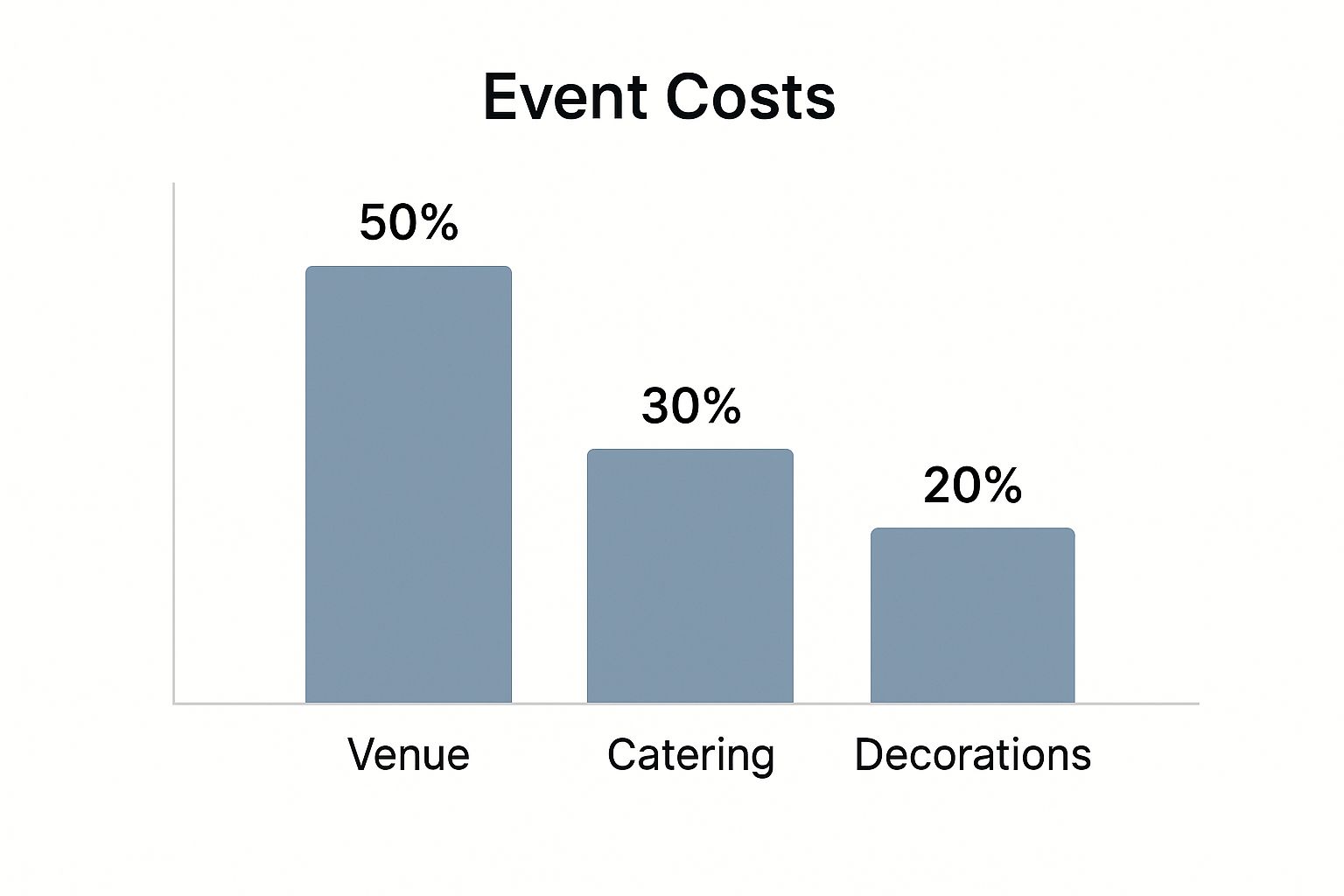Let’s talk about the single most powerful tool you have when planning an event: the budget. It’s the framework that guides every single decision, from picking the venue to finalizing the guest list. A solid budget is what lets you maximize your impact and pull off a truly memorable experience.
Why Your Event Budget Is More Than Just Numbers
I get it—creating a budget can feel like a chore. Too often, people see it as just a restrictive list of costs. But really, it’s all about creating clarity and direction for your event. When you have a well-planned budget, your whole team is aligned on the same financial page, which is the best defense against the dreaded "scope creep" that can derail even the most carefully organized plans.
This financial roadmap also puts you in a much stronger position when negotiating with vendors. When you know exactly what you can afford for catering, A/V, or entertainment, you can walk into those conversations with confidence and make decisions backed by real data.
✦A Strategic Roadmap for Success
Think of your budget less like a set of rules and more like a guide. It's there to help you prioritize spending on the things that will actually matter to your attendees. By allocating your funds intentionally, you make sure every dollar is working toward your event's goals.
A thoughtful budget isn't about limiting what you can do; it's about enabling you to do more with what you have. It turns financial constraints into a catalyst for creative and impactful planning.
If your company lives in Slack and Google Calendar, you know how quickly all the moving parts of an event can get chaotic. This is where a tool like Be There becomes incredibly useful. It simplifies event management by integrating directly into the tools your team already uses daily. Imagine tracking RSVPs and sending out automated reminders directly in Slack, with everything automatically syncing to your team's Google Calendars. This gives you a real-time headcount, which is absolutely critical for accurate budgeting—especially for per-person costs. That kind of seamless clarity prevents overspending and costly last-minute scrambles.
✦Connecting Your Budget to the Bigger Picture
Ultimately, your budget is a direct reflection of your event’s strategic priorities. It’s tied to your larger company objectives, whether that’s boosting team morale, launching a new product, or generating sales leads. A strong budget ensures your financial plan supports these goals from the very beginning.
This whole approach is a key part of building an effective event marketing plan. To see how budgeting fits into the bigger picture, check out our guide on creating a comprehensive event marketing plan.
Mapping Out Your Core Event Expenses
Diving into the numbers can feel overwhelming, so the best way to start is by breaking your budget for an event into smaller, more manageable pieces. The goal is to move from a vague, total figure to a detailed, line-by-line list of every possible cost. When you categorize your expenses logically, you’re not just making a list—you’re creating a financial roadmap that’s far easier to track and control.
Start by thinking about the non-negotiables. These are the big-ticket items that form the backbone of your event, and they're usually the first vendors you'll book. Once you've got a handle on your main spending areas, you can think strategically about how to divvy up your funds. A big part of this process is learning how to prioritize, which is why mastering resource allocation optimization is such a valuable skill for any event planner.
This visual gives you a quick look at how a simple corporate event budget often breaks down.

As you can see, the venue and catering almost always take the biggest slice of the pie.
✦The Big Three Fixed Costs
For most in-person events, you can bet that three specific categories will dominate your budget. Getting a solid grasp on these will help you make smarter decisions right from the start.
- Venue Rental: This is almost always your single largest expense. It covers the space itself, but don't forget to ask about potential add-ons. Things like security, cleaning fees, or mandatory insurance can sneak up on you.
- Catering (Food & Beverage): What you serve your guests has a massive impact on their experience—and your bottom line. Since this is a variable cost, it scales directly with your final attendee count.
- A/V Production: This bucket covers everything from microphones and speakers to projectors, special lighting, and any tech needed for live-streaming. You can't skimp here; quality A/V is what makes an event feel professional and engaging.
✦Why an Accurate Headcount Is Everything
So many of your costs are tied directly to attendance, which makes getting a reliable RSVP count absolutely critical. If your company lives in Slack and Google Calendar, you've probably seen how easily traditional email invites get lost in the shuffle, leading to endless follow-ups and inaccurate estimates.
This is exactly where a tool like Be There is so handy. It lets you create and manage your events right inside Slack, where your team is already working, and syncs everything to Google Calendar. You can track RSVPs in real-time and send out automated reminders, giving you a much more precise headcount. That clarity is a huge budget-saver, preventing you from overpaying for food or booking a venue that's way too big.
By bringing event management into your team's existing workflow, you take the guesswork out of planning. Accurate attendance data means you can confidently commit to vendor numbers without wasting a single dollar.
✦The Small Details That Add Up Fast
Beyond the major expenses, there are dozens of smaller costs that can quickly blow up your budget if you don't track them. It’s essential to account for these from the very beginning to avoid any nasty surprises down the road.
Make sure you've thought about costs like:
- Marketing and Promotion: This could be anything from digital ads and email campaigns to printed flyers.
- Speaker Fees and Travel: Don't forget to budget for accommodation and per diems for your presenters.
- Decor and Signage: Think branded banners, welcome signs, and table centerpieces.
- Staffing: Do you need on-site support, registration staff, or dedicated technical assistants?
- Software and Technology: This includes event registration platforms, mobile apps, or any payment processing fees.
For a little perspective, industry data shows that the typical conference budget in the United States for 2025 is around $1.89 million for an average of 601 attendees. Food and Beverage leads the spending at 29.9%, followed by Audio/Visual at 15%. Knowing these benchmarks can help you see if your own allocations are on the right track.
Budgeting for Virtual and Hybrid Events

When you take an event online, the financial playbook gets a major rewrite. Building a budget for an event that’s virtual or hybrid means you're trading one set of expenses for another. While you might be saving a bundle on things like venue rentals and catering, you’ll be redirecting that money into the tech that makes it all happen.
The heart and soul of any virtual event budget is the technology. Think of it as your foundation—this covers everything from the event platform subscription to high-quality streaming and the technical support team that keeps the show running smoothly for your remote attendees.
✦The New Cost Landscape
Hybrid events are a different beast altogether. You're essentially planning two events at once, which means you’re juggling the typical costs of an in-person gathering plus the entire digital infrastructure. It's a balancing act that demands some serious financial foresight.
Here are the key technology expenses you absolutely need to factor in:
- Event Platform: This is your virtual venue. The price tag can swing wildly depending on what you need, from simple streaming to interactive networking lounges and virtual exhibitor booths.
- A/V Production and Streaming: If you want to keep your remote audience glued to their screens, professional-grade cameras, mics, and a solid streaming service are non-negotiable. Don't skimp on a skilled production crew; they're worth every penny.
- Digital Marketing: Your promotion is going to live online. Think social media ads, targeted email campaigns, and content marketing designed to find and register your virtual attendees.
While that might sound like a lot, the savings can be massive. On average, virtual events can cost up to 75% less than their in-person counterparts. This frees up a ton of cash to invest back into creating an amazing attendee experience. Getting this right is everything, and you can dive deeper by checking out our hybrid meeting best practices.
✦Optimizing Your Digital Budget
The digital event world is booming, and it's projected to be worth a staggering $236.69 billion in 2025. But here's the catch: while event costs are expected to climb by about 12% next year, overall budgets are only projected to grow by 11%. That gap makes smart, efficient budgeting more important than ever. You can read more about 2025 event planning trends on encoreglobal.com.
This is where a tool like Be There can be a game-changer, particularly for internal company events where the team uses Slack and Google Calendar. When you can create and manage events right from Slack, you get a real-time, accurate headcount. That clarity is gold for both hybrid and virtual planning—it lets you forecast your platform user count precisely so you aren't paying for licenses you don't need, and it ensures the right people have the event on their Google Calendar automatically.
By bringing event management directly into your team's daily workflow, you kill the guesswork. An accurate attendee count lets you budget with confidence, ensuring you have the right technology and resources to deliver a polished and engaging digital experience.
Plan Your Event Where Your Team Already Works
If your company runs on Slack and Google Calendar, the last thing you need is another clunky, standalone tool for event planning. Let's be honest, forcing your team to learn and manage a new platform is a major productivity killer. This is where a smart integration becomes your secret weapon for saving time and, more importantly, money when you're building an event budget.
Think about it: your team's most valuable resource is their time. Making them jump between apps to RSVP or check event details creates friction and wastes hours that are better spent on what actually matters—like creating an amazing experience for your attendees. The most effective approach is to manage the entire event lifecycle right where your team already collaborates every day.
✦Nail Your Headcount Without Chasing People Down
Getting an accurate headcount is one of the trickiest parts of budgeting. So many of your costs—from catering and venue space to swag and rentals—are priced on a per-person basis. If you get the numbers wrong, you're either burning money on no-shows or paying a premium to accommodate extra guests at the eleventh hour.
This is where a tool like Be There completely changes the game by bringing event management right into Slack and syncing with Google Calendar. Invitations and RSVPs happen where your team is already talking, so you get responses instantly. It's just a natural part of their daily workflow, and accepted invites automatically appear on their calendar.
Here’s a look at how simple and clean event creation can be, right from a Slack channel.
By meeting your team where they are, you get a real-time, accurate headcount with almost zero effort. That kind of clarity is exactly what you need to avoid overspending and prevent those painful last-minute surcharges from vendors.
✦The Hidden Costs of Clunky Planning
Inefficient planning isn't just an annoyance; it's a direct hit to your budget. Every minute your team spends manually tracking down RSVPs, updating messy spreadsheets, and sending reminder after reminder is a hidden cost that sucks up resources. All that administrative busywork pulls focus from high-impact tasks, like negotiating better deals with vendors or curating the perfect event agenda.
The big takeaway is this: when your event tool is part of your team's natural workflow, you eliminate friction. This doesn't just save a ton of time; it gives you the hard data you need to make smarter, cost-effective budgeting decisions.
Here’s a real-world example. If you can lock in your final headcount a week out, you can finalize that catering order with confidence. This helps you dodge the 10-15% rush fee many vendors add for last-minute changes. For an event with 100 people, that's a few hundred, or even thousands, of dollars saved right there. This kind of strategic thinking is a key part of what we cover in our guide to project management for events.
At the end of the day, streamlining your planning process does more than just make your life easier. It empowers you to build a tighter, more accurate budget, making sure every dollar you spend contributes to a truly memorable event.
Keeping Your Spending on Track

Alright, so you’ve built your budget for an event. That's a huge step, but honestly, it’s just the starting line. The real test is sticking to that budget when the planning chaos truly begins. A budget spreadsheet that sits forgotten in a folder is worthless—it has to be a living, breathing guide for every spending decision your team makes.
This is where diligent tracking comes in. It’s about moving from a plan on paper to day-to-day financial management. You need a system that accounts for every dollar, from the big venue deposit down to that last-minute run for extra name tags. That kind of transparency is the only thing that stops tiny overages from spiraling into a massive budget crisis.
✦Creating a System for Accountability
One of the best things you can do is assign ownership for different parts of the budget. Make one person the point person for catering, another for marketing, and so on. When someone is directly responsible for a category, they're much more likely to track every single expense within it. It’s a simple way to decentralize the work and make the total budget feel a lot less overwhelming.
Of course, this only works if everyone is on the same page. A shared tracking document is non-negotiable. It could be a powerful Google Sheet or a project management tool like Asana or Trello. The key is that it’s accessible to the whole team.
At a minimum, your tracker should have columns for:
- Projected Costs: What you originally estimated for each item.
- Actual Costs: The real number once an invoice is paid.
- Variances: The difference between your projected and actual costs.
Then, you need to hold regular budget check-ins. A quick weekly huddle to review the numbers is essential for catching problems early. If you see A/V costs are already creeping 5% over budget, you can figure out a solution now instead of getting a nasty surprise right before the event.
A budget isn't a "set it and forget it" document. It’s a dynamic guide that requires constant attention. Consistent tracking is what transforms your financial plan from a hopeful guess into a reliable roadmap.
✦The Importance of a Contingency Fund
I’ve been planning events for a long time, and I can tell you this: something always goes wrong. No matter how perfectly you plan, unexpected costs will pop up. A vendor suddenly hikes their prices, a key piece of a equipment fails and needs a last-minute replacement, or you realize you need more security staff. This is exactly what a contingency fund is for. It’s your financial safety net.
A good rule of thumb is to set aside 10-15% of your total event budget just for these surprises. Think of it as a dedicated buffer, not "extra" money to play with. This fund gives you the breathing room to handle problems without having to cut corners elsewhere, ensuring your attendees have a great experience no matter what happens behind the scenes.
Got Questions About Event Budgeting? We've Got Answers

Even the most seasoned planners hit a few snags when mapping out an event budget. It's totally normal. Let's walk through some of the questions I hear all the time so you can feel confident locking in your numbers.
One of the first things people want to know is the single biggest mistake to avoid. Hands down, it's underestimating your expenses and skipping the contingency fund. It’s so easy to get fixated on the big-ticket items like the venue or catering and completely forget about the smaller costs that pile up—things like taxes, service fees, and insurance.
Think of your contingency fund as non-negotiable. Setting aside at least 10-15% of your total budget is a must for handling those inevitable last-minute surprises.
Another common question is about cutting costs without making the event feel cheap. You actually have a lot of options here. Try scheduling your event on a weekday or during the off-season; you'll often find venues are much more flexible with their rates. And don't be afraid to negotiate with your vendors! Many are willing to create package deals, especially if you plan on bringing them repeat business.
✦How Can I Accurately Estimate My Attendee Count?
Getting your headcount right is a huge piece of the puzzle, since so many of your costs are priced per person. The best place to start is with your own history. Look at past events and compare how many people registered versus how many actually showed up. If this is your first go-around, check out similar events in your industry to get a rough benchmark.
When it comes to internal company events, the best way to get an accurate headcount is to meet your team where they are. Stop relying on emails that get buried or clunky tools nobody wants to use.
This is where your daily workflow can be your biggest ally. For companies that practically live in Slack and Google Calendar, a bad headcount is usually just a symptom of a disconnected planning process. It’s tough to get a solid RSVP count when your invitation is lost in a sea of unread emails.
A tool like Be There brings event management right into Slack, solving this problem instantly. You can create the event, watch the RSVPs roll in, and send out reminders all within the one platform your team actually uses, while automatically adding the event to their Google Calendar. This gives you a real-time, accurate count, which is gold for your budget. You can finalize that catering order or book the right-sized space without guessing and wasting money.
✦What Is the Best Way to Manage a Hybrid Event Budget?
Budgeting for a hybrid event is tricky because you're essentially planning two separate experiences—one for your in-person crowd and another for your virtual one. The secret is to invest in the technology that connects those two audiences and makes them feel like they're part of the same event.
Here's where I'd focus my spending:
- High-Quality Streaming: This isn't the place to cut corners. You need professional cameras, good audio, and a streaming platform that won't crash.
- An Engaging Virtual Platform: This is your online "venue." It should have interactive features that pull people in, like live polls, Q&A sessions, and virtual networking rooms.
- A Dedicated Tech Team: You need an expert crew on-site to manage the A/V and someone dedicated to the virtual broadcast. This ensures a seamless experience for everyone, no matter where they are.
When you prioritize these areas, your remote attendees feel just as important and engaged as the people in the room.
Ready to take the guesswork out of your event planning and nail your budget every time? Be There is the first event planner built for Slack, making it simple to manage company events right where your team works. Learn more and start your free trial at https://be-there.co.

Planning your internal events has never been easier!
No more scheduling headaches—our Slack-connected web app keeps things simple. Less email, more fun! 🚀
